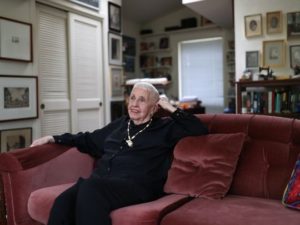School of Dance’s Nancy Smith Fichter Connects Dancers with the Language of Movement
The Martha Graham Dance Company
Tuesday, February 27th, 2018 at 7:30pm
Wednesday, February 28th, 2018 at 7:30pm
Tickets: $55 and $25. Call 850-644-6500 or visit openingsnights.fsu.edu.
Nancy Smith Fichter Dance Theatre
Article courtesy of The Tallahassee Democrat written by Marina Brown, Democrat correspondent

Nancy Smith Fichter at her home on Friday, Feb. 9, 2018. Fichter has been pivotal part of the FSU Dance department for years, including having the dance building named in her honor, and has danced with Martha Graham Ballet which will be featured in an upcoming Opening Nights performance. (Photo: Joe Rondone/Democrat)
Like to play with analogies? Well, here is one that is apt. How is contemporary dance like a fine heritage tomato?
Go on, guess again.
The answer, in this case, is that the ‘genetics’ are passed down. The essence, the emotional ‘flavor’ flows through generations. In the case of the fruit, it is in the color, the form, but also in the burst of recognition of a beloved taste, of coming home. With dance, as it travels through bodies and is interpreted by searching minds, this essence is carried by training and a central philosophy that brings new revelations, but in a vernacular that at a profound level we all understand — that perhaps we all need.
On Feb. 27 and 28, Tallahassee will have the opportunity to see how ‘heritage’ and ‘lineage’ play out when the New York-based Martha Graham Company presents the world-premiere of a new work by FSU Assistant Professor, Gwen Welliver.
In a jointly commissioned project by the Graham group and Opening Nights, Welliver’s new work will be “a response” to one of choreographer Graham’s most famous works, Lamentation. Nearly a dozen internationally-known choreographers tapped by Graham’s company, have already offered up what Welliver calls “their array of voices” to the Lamentation “prompt,” each using their own choice of music and their own unique vocabulary.
Rather like a professor who sees his student’s new thought based on his old idea, or a parent’s love of music surfacing in his prodigy’s tiny fingers, the opportunity to see Martha Graham’s company as well as ‘newly born’ choreography is both a nod to the past and a full-fledged statement of the present.

Nancy Smith Fichter at her home on Feb. 9, 2018. Fichter has been pivotal part of the FSU Dance department for years, including having the dance building named in her honor, and has danced with Martha Graham Ballet which will be featured in an upcoming Opening Nights performance. (Photo: Joe Rondone/Democrat)
Today, there are still those among us who know firsthand of Martha Graham’s 92-year-old disruption of the dance world that came to be called “modern dance” —and with its arrival, shattering the century-old rules of classical ballet. One of them is Professor Emerita Nancy Smith Fichter, who still feels the thrill of ground-breaking transgressions when she sees new works created by the likes of Welliver. Fichter has even “transgressed” some herself as the first Chair of the Department of Dance at Florida State University.
Today at 87, Fichter positively glows. With a dazzling smile, her trademark cropped snowy hair, and intelligent eyes that pick up everything, her conversation ranges from forms of dance, her personal mentorship by Graham’s close musical collaborator, and casual literary allusions to Dumas, fils and Proust.
In her soft Florida drawl, Fichter chronicles the history of modern dance from her own first exposure at a summer camp through the current Post-Modern and Post Post Modern experimentations. “For me, watching those early movements, not always pretty ones… it felt familiar the first time I saw them. It was a vernacular that I immediately understood.”
And as a young college student, Fichter wanted more. Even though she enrolled at Florida State on her way to earning a Bachelor’s in English that over the years would become a Master’s, her heart has surrendered to dance. “Giving in” some years later, Fichter would eventually earn her Ph.D. in Dance and Related Arts. But it wasn’t just a cerebral infatuation.
“During my college days, every summer I traveled to New York or Connecticut where Graham held classes,” she says. “Martha Graham, though she looked so formidable on stage, was actually a very tiny woman. But her presence, even in class, was immense. She spoke softly, expected everything, and if you didn’t produce it, her look could be devastating.”
It was during those years of the ’50s when Graham was collaborating with Stravinsky and Copeland, that Fichter herself was taken under the wing of Louis Horst, Graham’s musical director. “Movement isn’t the only thing,” she says. “Understanding music and its own patterns is vital.”
Over the years, FSU’s dance classes had remained under the aegis of the Department of Physical Education, a kind of “pretty cousin” to the athletes. But now, having returned from a stint as Professor of Dance at Sam Houston University, things were about to change for Fichter. “I was asked to create a true Department of Dance that would be part of the School of Music, whose Chair encouraged her to make the new Department, “the best dance program in the country.” Her academic credentials were stellar and her history as a disciple of Martha Graham made Fichter the perfect choice.

From 1968 until 1997 Nancy Smith Fichter not only taught classes and choreographed her own modern works, but led what would become the School of Dance with a catholic embrace of movement. Suzanne Farrell, from the New York City Ballet would become a professor, as would Anjali Austin of the Dance Theatre of Harlem, Dan Wagoner of the Martha Graham, Merce Cunningham and Paul Taylor companies, and Jawole Zollaar, founder and Artistic Director of Urban Bush Women, among other illustrious creators from the worlds of both ballet and modern dance.
Even after retiring, for 15 years Fichter continued to teach and direct dance works at FSU. She established the Lillian E. Smith Foundation that provided a rural retreat for artists of every persuasion. And the Nancy Smith Fichter Dance Theatre in Montgomery Hall has been named to honor her contributions.
Like Martha Graham herself whose “matriarchy” has influenced Fichter’s generation, so has it flowed on to that of Gwen Welliver, “more eloquent,” says Fichter, “more complex, with a greater vocabulary.”
Though Martha Graham’s distinct technique may metamorphose into that of others, it is likely her sensibilities may seep up and out of the newest iterations of contemporary dance, fueled by bright, young rule-breakers speaking in their own dialects, but in a language all will understand.
